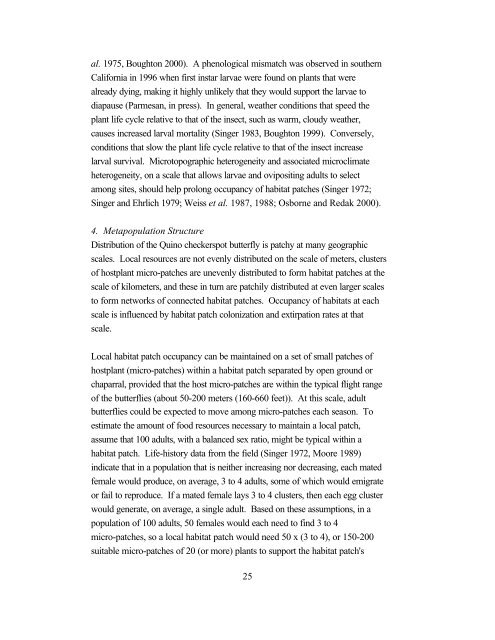Outline of Quino Recovery Plan - The Xerces Society
Outline of Quino Recovery Plan - The Xerces Society
Outline of Quino Recovery Plan - The Xerces Society
Create successful ePaper yourself
Turn your PDF publications into a flip-book with our unique Google optimized e-Paper software.
al. 1975, Boughton 2000). A phenological mismatch was observed in southern<br />
California in 1996 when first instar larvae were found on plants that were<br />
already dying, making it highly unlikely that they would support the larvae to<br />
diapause (Parmesan, in press). In general, weather conditions that speed the<br />
plant life cycle relative to that <strong>of</strong> the insect, such as warm, cloudy weather,<br />
causes increased larval mortality (Singer 1983, Boughton 1999). Conversely,<br />
conditions that slow the plant life cycle relative to that <strong>of</strong> the insect increase<br />
larval survival. Microtopographic heterogeneity and associated microclimate<br />
heterogeneity, on a scale that allows larvae and ovipositing adults to select<br />
among sites, should help prolong occupancy <strong>of</strong> habitat patches (Singer 1972;<br />
Singer and Ehrlich 1979; Weiss et al. 1987, 1988; Osborne and Redak 2000).<br />
4. Metapopulation Structure<br />
Distribution <strong>of</strong> the <strong>Quino</strong> checkerspot butterfly is patchy at many geographic<br />
scales. Local resources are not evenly distributed on the scale <strong>of</strong> meters, clusters<br />
<strong>of</strong> hostplant micro-patches are unevenly distributed to form habitat patches at the<br />
scale <strong>of</strong> kilometers, and these in turn are patchily distributed at even larger scales<br />
to form networks <strong>of</strong> connected habitat patches. Occupancy <strong>of</strong> habitats at each<br />
scale is influenced by habitat patch colonization and extirpation rates at that<br />
scale.<br />
Local habitat patch occupancy can be maintained on a set <strong>of</strong> small patches <strong>of</strong><br />
hostplant (micro-patches) within a habitat patch separated by open ground or<br />
chaparral, provided that the host micro-patches are within the typical flight range<br />
<strong>of</strong> the butterflies (about 50-200 meters (160-660 feet)). At this scale, adult<br />
butterflies could be expected to move among micro-patches each season. To<br />
estimate the amount <strong>of</strong> food resources necessary to maintain a local patch,<br />
assume that 100 adults, with a balanced sex ratio, might be typical within a<br />
habitat patch. Life-history data from the field (Singer 1972, Moore 1989)<br />
indicate that in a population that is neither increasing nor decreasing, each mated<br />
female would produce, on average, 3 to 4 adults, some <strong>of</strong> which would emigrate<br />
or fail to reproduce. If a mated female lays 3 to 4 clusters, then each egg cluster<br />
would generate, on average, a single adult. Based on these assumptions, in a<br />
population <strong>of</strong> 100 adults, 50 females would each need to find 3 to 4<br />
micro-patches, so a local habitat patch would need 50 x (3 to 4), or 150-200<br />
suitable micro-patches <strong>of</strong> 20 (or more) plants to support the habitat patch's<br />
25
















